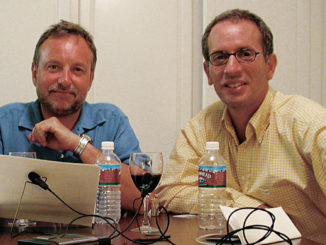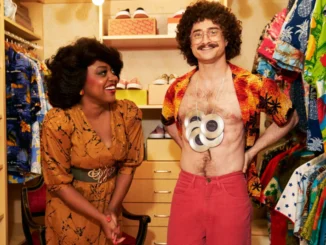
By Kristin Marguerite Doidge
Film music should be felt and not necessarily heard. That’s one of the central tenets music editor Jillinda Palmer, MPSE remembers learning early on from her mentors.
“We don’t want to beat people over the head with emotion,” she said. “That was a hard thing for me to learn. They really taught me how to listen and what to listen for in the context of the entire soundscape once dialogue, music, and sound effects are all added in. At the end of the day, dialogue is always first, so I think being with my mentors really taught me to listen for dialogue and listen for the story.”
As the music editor for the recent hit series “Lady in the Lake” for AppleTV+, starring Natalie Portman and Moses Ingram, Palmer worked closely with showrunner Alma Ha’rel and music supervisor Linda Cohen to do just that: Ensure the
show’s music was authentic and fit the period to amplify the gripping and immersive story set in late 1960s Baltimore.
Palmer’s early work in sound design and sound effects in animation helped her understand how to build a universe from the ground up.
“It’s almost like a blank canvas that you’re going to fill to bring people in and establish a world,” Palmer explained. A big part of her role is often serving as the connector between sometimes disparate departments to become the common throughline between the director, the editors, and the music team.
She discovered the show’s composer, Marcus Norris, while searching for temp score music, and suggested him to Ha’rel because she felt his musical style fit the show perfectly.
“I like to say in sound design, you’re only as good as your library,” Palmer said. “Alma really wanted it to be instruments and sounds that were authentic to the time period, but she also wanted a lot of almost ASMR (autonomous sensory meridian response) elements. Marcus ended up adding a lot of breathing, a lot of very delicate percussion sounds, a little tapping and woodblocks and things that just kind of catch your ear, but you might not really know what it is at first. That was really important to Alma. And we all got pretty nerdy with that.”
As the show came together, Norris felt that having Palmer’s guidance was essential.
“We all wanted her in the room, almost regardless of what we were working on that day,” he said. “We just (rightly) assumed that we could use her help.”
The show boasts an exceptional soundtrack and meticulously curated music selections from the 1960s — including Nina Simone’s “Sinnerman” and Shirley Bassey’s “The Impossible Dream” — that imbue each episode with a distinctive and immersive atmosphere. Many of the songs were in the script, but capturing the precise mood required a lot of creative collaboration.
“This rich, authentic soundscape is the result of months of dedicated, passionate, and uncompromising collaboration with Jillinda,” picture editor Yael Hersonski said. “As an editor, and especially on this show, I rely heavily on the music to not only set the mood and tone but to enhance the emotional depth and pacing of each scene. Jillinda has an impeccable ability to understand this balance and consistently delivered music edits that fit seamlessly into the narrative.”
One of the most challenging aspects of accomplishing this on “Lady in the Lake” came during Episode 3 when music from a jazz club morphs from being played live on stage, to playing over a montage, to playing in the background on a record player. The result is an example of how music helped Ha’rel’s heightened, surreal vision for the show to shine through.
“When you make a seven-hour show with many challenging musical cues, you often need to be creative in ways you can’t foresee,” Ha’rel said. “Jillinda was always there to meet us at every junction. Her background in music gives her that ability to vibe like a band member, which is my favorite way of working.”
Indeed, Palmer is an active performing musician whose band happens to be a ‘60s soul group, which made working on this particular show even more fulfilling. To keep her musicianship sharp, she regularly performs live as a vocalist with bands such as Tom Kenny & The Hi-Seas, DJ Lance Rock, and The Monolators and works as a multi-instrumentalist and arranger for recording sessions.
“I even had a girl group before this with three girls, and we matched in dresses and did a three-part harmony,” she said. “Our biggest influences were bands from this era — the Supremes, the Cookies, the Shangri-Las. So when I learned that this was what Alma was going for, I was like, ‘Oh my God, I know this genre better than any other genre.’ I was beside myself thinking, ‘This is the best.’”
Over the past 20 years, Palmer’s passion for performance as a musician has been essential in her work as a music editor, and vice versa. In 2003, she studied audio recording and music performance at the Musicians Institute in Hollywood. This led her to the postproduction field where she began working as a sound effects editor, sound designer, and dialogue editor. In 2012, she decided to focus on music editing, and took a job at Pitch ‘n Sync under music editor Jennifer “Jenny” Barak, who’d worked on hits including “Grey’s Anatomy” and “Donnie Darko.” While there, Palmer saw how working as a music editor would allow her to apply her fundamental knowledge of music and her editorial expertise to enhance her clients’ musical intent.
Over the years, she said she’s been mentored by many great music editors, including Moira Marquis, Micha Liberman, Emily Kwong, Edwardo Ponsdomenech, along with composers such as Joey Newman, Frank Ciampi, and Andy Paley. Some of her best-known projects have included music editing on “Deadwood: The Movie,” “Crazy Ex-Girlfriend,” and “Virgin River.”
But with every new show that comes her way, she said she continues to learn new techniques and appreciates keeping up with current technology — something she and her fellow music editors try to help one another with by staying in touch and sharing ideas and tips. Up next, Palmer is music editing Duke Johnson’s upcoming film, “The Actor,” with music by Richard Reed Perry of Arcade Fire.
She hopes her story will inspire and educate more people — especially women — about music editing as a possible career. She also wants to remind directors, showrunners, and others working in postproduction how music editors can support their goals and make a project even better, particularly as the industry as a whole evolves.
“We can’t be invisible,” she said of herself and her fellow music editors. “Our job is going to go away if we don’t advocate for ourselves. I know great picture editors can edit music, but that makes my job even better, because I can work with them and speak musically with them. I can say, ‘I see where you’re going and I’m going to help you get there.’”





